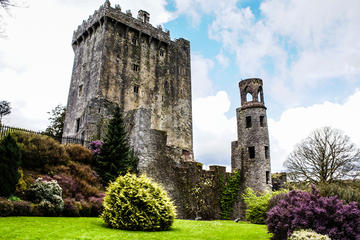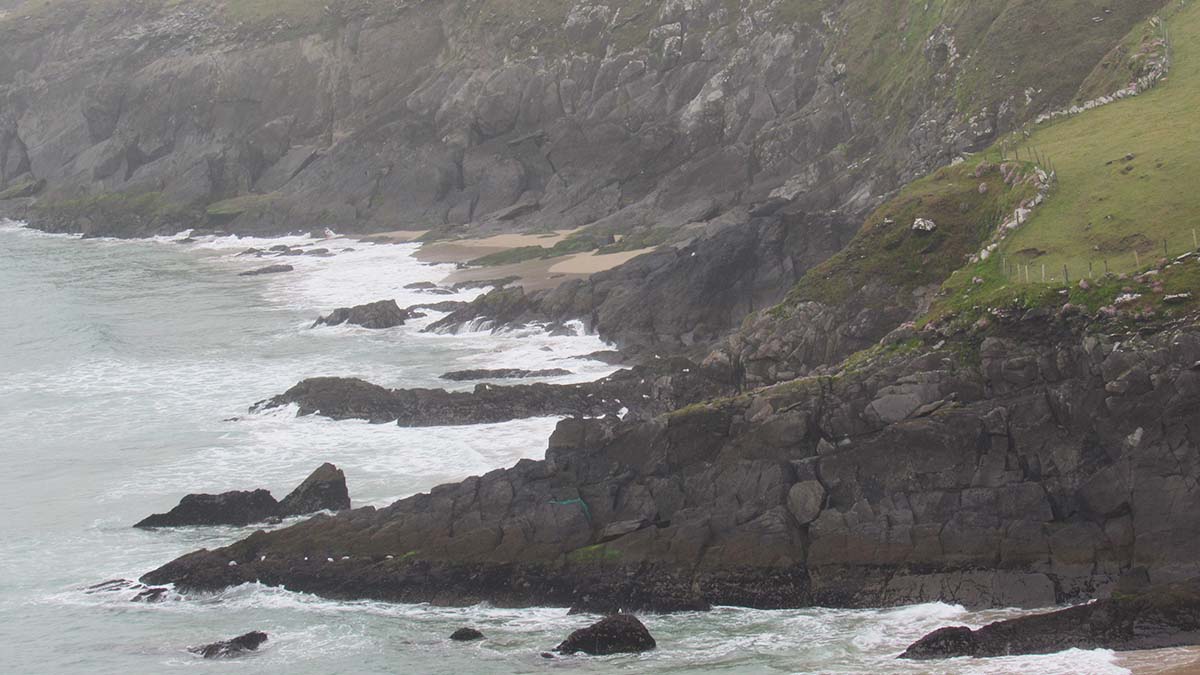
by Jessica Cook
The chilly Atlantic pushed our ferry off the coast of Ireland towards the rocky Aran Islands in the distance, each wave colored a blue deeper than midnight. When we disembarked, the mist creeping down the rocky bluffs of the island and the sea spray caught in my hair. I had been in Ireland for over a week now, and for my first visit I had adjusted surprisingly well to the constant misting. Maybe it was growing up in the Houston, Texas humidity that had prepared me so well.
A lanky black and white border collie ran up the beach to greet us. Apparently, as the captain later told us, he waits there every day to greet the tourists. My fellow study abroad students played fetch with him for a bit with a piece of driftwood and I was reminded of my own border collie back home.
Then we all swarmed the small bicycle rental booth and were off. The hilly terrain and wet air tested our endurance, but not as much as the wind. As my classmates raced by, determined to beat each other around the island, I slowed my pace and soon was alone with the wind and the rocks. I walked beside my rental bike and pulled my raincoat’s hood up over my hair. The mist coming off of the sea gave my face a sloppy, wet kiss. Here on the craggy island of Inis Mór, everything seemed desolate. Desolate and beautiful.
 The gravel road that wound around the island was hemmed in with crooked walls of large stone coming up waist high. I had seen many stone houses and fences on my tour of the country. Everything seemed preserved just the way it was in the early 1900s. Donkeys still are used to farm since today’s technology-savvy vehicles still can’t cope with the harsh landscape. The houses are still built from stone with the occasional thatched roof, lending even more to the feeling of being stuck in history.
The gravel road that wound around the island was hemmed in with crooked walls of large stone coming up waist high. I had seen many stone houses and fences on my tour of the country. Everything seemed preserved just the way it was in the early 1900s. Donkeys still are used to farm since today’s technology-savvy vehicles still can’t cope with the harsh landscape. The houses are still built from stone with the occasional thatched roof, lending even more to the feeling of being stuck in history.
A shepherd with his sheepdog trotting at his side passed me on the road and gave me a smile. I waved back and he rounded the bend, disappearing from sight, and I had to wonder if he had even been there in the first place.
Around me, the coarse grass blew in the sea wind and looked a strange yellow under the gray-tinged sky. There were no sounds except for the empty wind and the crashing of waves far below. Even though the island seemed utterly abandoned at any brief moment, all I had to do was match the island’s slower pace and things began to come alive.
Squat, round bellied donkeys with shaggy hair covering up their eyes came quietly over to the stone fence. I patted one on the head and let it snuffle the air around me. Standing there with the wind and mist, I slowly began to realize why time seemed to move so slowly here.
There were no birds, trees, or transient flowers to alert me to the quick passing of time. Only hardy creatures endured here; island grass that looks withered year round, hardworking donkeys, and cold stone. I was the out of place one, a young traveler in my early twenties, a head of soft blonde hair, and a raincoat the color of spring roses.
 The donkey snuffled some more at me and his fellow came over to inspect the splash of color in their world of grays, greens, and browns.
The donkey snuffled some more at me and his fellow came over to inspect the splash of color in their world of grays, greens, and browns.
I took up my bike and tried to ride it once more but the wind caused me to dismount after a few lengths down the road. As I walked into the wind, holding my bike with one hand and my hood on with the other, I could hear the grunts and snorts of seals on the rocky beach below. I propped my bike up against the stone wall and leaned over to look down from the outcropping.
A group of harbor seals, brown and gray in color, lounged on the rocks near the cold water like I would lounge at the pool. They looked up at me as I stood there shivering, staring back at them. One leaned its head back as if to sunbathe in the almost sunless sky, its body contorted around the narrow rocky ledge it was perched on. But the seal looked perfectly comfortable that way.
As they grunted to one another, I could imagine them discussing the waif of a girl leaning on the overhang to observe them. One of them had probably decided that if I should fall over, the seals closest should help me to shore.
I walked my bike around the loop, looking at the harsh silhouette of the island against the darkening sky. I felt as if I was in the presence of something very great and powerful. The strength of the stone walls lining my path, protecting me from the wildness that occasionally crept over the sides in the form of grasses and vines, had stood that way for centuries themselves.
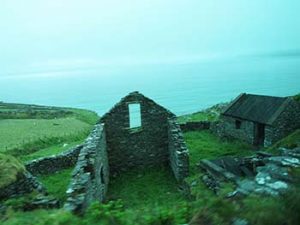 An abandoned farmhouse sat nestled back in a bluff. The four walls were still standing but the roof was missing. It had been a thatched roof and weaker than its stony counterparts. Things that are fragile and stamped with time can’t survive in this timeless land.
An abandoned farmhouse sat nestled back in a bluff. The four walls were still standing but the roof was missing. It had been a thatched roof and weaker than its stony counterparts. Things that are fragile and stamped with time can’t survive in this timeless land.
The wind bit my face and I could almost feel my skin growing taut and rough like the seaman’s who had helped us off the ferry when we first came over that day. The skin on his cheeks was ruddy and weather-beaten, his eyes glinting with the colors of the Atlantic sea that tries so very hard to overcome the stony outcropping the people called home.
My steps slowed and became heavier, more grounded. It was like my center of gravity had shifted, been pulled down to the sturdy stone beneath my feet. I mounted my bike and was able to pedal the rest of the way to the docks where our ferry would be leaving soon. The wind didn’t slow me as much as it did before and the donkeys only gave me an acknowledging glance instead of their usual concern.
When I came into town with my cheeks red and my hair tangled into knots that wound around my ears, I felt just a bit timeless myself. As if I could have been any creature that had made its way from the wilderness into civilization and survived the harshness of the landscape.
Once I returned my bike, I saw some of my friends from my study abroad group. We ducked out of the wind and mist to one of the few pubs on the island. There we warmed up and ate hamburgers while an old John Wayne western played on TV. It struck me as an odd thing to find something as American as hamburgers and John Wayne here in one of the most remote places I had ever visited. After we paid for our meal, we went out to meet the ferry once more, leaving two old Irishmen at the bar to finish watching the western.
 As I stepped onto the large boat that was to bring us back to the mainland, I couldn’t help but think how small it looked in comparison to the vast ocean and the white tipped waves. The boat pulled away from shore and I looked back at the wooden dock that jutted out into the churning waters. It was a dock that had survived, on a daily basis, extreme high and low tides. Upon arrival we had seen a sailboat sitting dry on the sand where we played with the dog. But now, it was already being buoyed slightly by the saltwater creeping up the shore. That old dock with its smoothed timbers seemed to me sturdier than the ferry built of plastic and metal carting us back.
As I stepped onto the large boat that was to bring us back to the mainland, I couldn’t help but think how small it looked in comparison to the vast ocean and the white tipped waves. The boat pulled away from shore and I looked back at the wooden dock that jutted out into the churning waters. It was a dock that had survived, on a daily basis, extreme high and low tides. Upon arrival we had seen a sailboat sitting dry on the sand where we played with the dog. But now, it was already being buoyed slightly by the saltwater creeping up the shore. That old dock with its smoothed timbers seemed to me sturdier than the ferry built of plastic and metal carting us back.
The island grew farther and farther away and I looked after it as long as I could make it out. In a way, the island was like the fountain of eternal youth, but the fountain of eternal age. Everything was born old but never grew any older. Everything there only grew stronger, and hung around far longer than what the natural concept of time says about each thing having its own place and time to exist.

 If You Go:
If You Go:
More on Inis Mór and the other Aran Islands as well as trip information if you’re wanting to visit:
The beautiful scenery and attractions on Inis Mór, like the spectacular cliffs and prehistoric sites:
The long history of the Aran Islands:
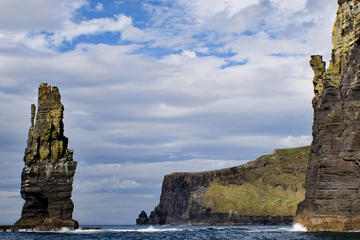
Aran Islands and Cliffs of Moher Day Trip from Galway including Cliff Cruise
About the author:
Jessica Cook is an enthusiastic traveler with her latest journey being a trip to England and Ireland. She is a self-proclaimed history buff and loves traveling to places where the sights are great and the stories abound. Her usual writing fare is historical fiction, but she likes to dabble in travel writing and creative nonfiction. To learn more about Jessica and access her blog and published short stories, visit http://jessicawalkerauthor.weebly.com/
All photos by Jessica Cook:
The coastline of Ireland while traveling through the Ring of Kerry.
One of the long haired donkeys on Inis Mór
A pair of long haired donkeys on Inis Mór
An abandoned stone house seen while traveling through the Ring of Kerry, similar houses were seen on Inis Mór but the amount of mist didn’t allow many pictures.
A grounded boat at the docks at Inis Mór while the tide was out.




 As we stood outside the former monastic site at Glendalough, our guide, Joan, directed us to the 900-year old gateway and indicated that the original structure had two round-headed granite arches supporting a timber roof. This was the gateway to civilization at the time. The lands beyond the monastic settlement teamed with highwaymen and other dangers. I imagined terrified individuals running past us through the gate to reach the cross-inscribed stone set just inside on the right as Joan explained that Glendalough was a place of refuge. The so-called “Sanctuary Stone” defined the point of safety for those on the run. Once a refugee passed inside the gate beyond the stone, he/she was safe.
As we stood outside the former monastic site at Glendalough, our guide, Joan, directed us to the 900-year old gateway and indicated that the original structure had two round-headed granite arches supporting a timber roof. This was the gateway to civilization at the time. The lands beyond the monastic settlement teamed with highwaymen and other dangers. I imagined terrified individuals running past us through the gate to reach the cross-inscribed stone set just inside on the right as Joan explained that Glendalough was a place of refuge. The so-called “Sanctuary Stone” defined the point of safety for those on the run. Once a refugee passed inside the gate beyond the stone, he/she was safe. In the vicinity of the round tower, the remains of a cathedral, dedicated to St Peter and St Paul, consist of a 10th century nave and a 12th century chancel. The arch, once finely decorated, is constructed of limestone imported from Bristol, England. A wall cupboard and basin used for washing the sacred vessels used in the mass is still visible in the sacristy.
In the vicinity of the round tower, the remains of a cathedral, dedicated to St Peter and St Paul, consist of a 10th century nave and a 12th century chancel. The arch, once finely decorated, is constructed of limestone imported from Bristol, England. A wall cupboard and basin used for washing the sacred vessels used in the mass is still visible in the sacristy. The postcard-like view of the upper lake features green hills gently rolling into the water on your left and trees at the water’s edge on your right. Opposite you in the distance, a stream descends the mountain into the lake. This tranquil setting greeted St. Kevin almost 14 centuries ago.
The postcard-like view of the upper lake features green hills gently rolling into the water on your left and trees at the water’s edge on your right. Opposite you in the distance, a stream descends the mountain into the lake. This tranquil setting greeted St. Kevin almost 14 centuries ago. Walking on, you enter a grove of trees to find the derelict 11th century Reefert Church with its stone nave and chancel. This church was a major attraction for those on pilgrimage to Glendalough as St. Kevin’s relics were housed here after his death.
Walking on, you enter a grove of trees to find the derelict 11th century Reefert Church with its stone nave and chancel. This church was a major attraction for those on pilgrimage to Glendalough as St. Kevin’s relics were housed here after his death.
 Slowly Diane and I climbed to the summit of the 300-foot high limestone promontory known as the Rock of Cashel. At the top, we were rewarded with a panoramic view of the green fields of County Tipperary below and the town of Cashel at the base. Despite the presence of the town below, the rock feels isolated.
Slowly Diane and I climbed to the summit of the 300-foot high limestone promontory known as the Rock of Cashel. At the top, we were rewarded with a panoramic view of the green fields of County Tipperary below and the town of Cashel at the base. Despite the presence of the town below, the rock feels isolated. Set next to the round tower, you find the shell of the second cathedral on site, dating to 1235. The current gray stone structure is cruciform with a central tower. The nave, which was never completed, is shorter than the choir. The north transept houses three sarcophagi, dating the 16th century, each with carved bas reliefs of the apostles around the periphery. The Protestant Church of Ireland abandoned this cathedral in the mid 17th century and then had the roof removed to collect the lead for ammunition. The cathedral lacks a roof to this day.
Set next to the round tower, you find the shell of the second cathedral on site, dating to 1235. The current gray stone structure is cruciform with a central tower. The nave, which was never completed, is shorter than the choir. The north transept houses three sarcophagi, dating the 16th century, each with carved bas reliefs of the apostles around the periphery. The Protestant Church of Ireland abandoned this cathedral in the mid 17th century and then had the roof removed to collect the lead for ammunition. The cathedral lacks a roof to this day. Inside the chapel, you find a white vaulted ceiling with plaster fragments falling off. The whitewash, dating from the Reformation in the 16th century, was used to cover the oldest frescoes in Ireland including those of the Nativity. An intricately carved sarcophagus at the back of the chapel might possibly be that of King Cormac himself.
Inside the chapel, you find a white vaulted ceiling with plaster fragments falling off. The whitewash, dating from the Reformation in the 16th century, was used to cover the oldest frescoes in Ireland including those of the Nativity. An intricately carved sarcophagus at the back of the chapel might possibly be that of King Cormac himself.
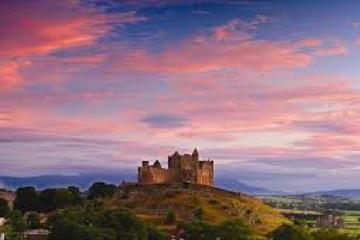

 Visiting the Air India memorial is not easy, and the usual response from people in Ireland was “never heard of it” and occasionally, “I remember something about that. When did it happen?” The memorial is not on any tour route nor do tour buses get close so I organized my visit through the hotel in Killarney where I was staying. Killarney is the largest town in the area and a major southern Ireland tourist spot. A local cabbie, who does customized tours, offered a flat rate for the day. The other option, and cheaper choice, would have been to rent a car.
Visiting the Air India memorial is not easy, and the usual response from people in Ireland was “never heard of it” and occasionally, “I remember something about that. When did it happen?” The memorial is not on any tour route nor do tour buses get close so I organized my visit through the hotel in Killarney where I was staying. Killarney is the largest town in the area and a major southern Ireland tourist spot. A local cabbie, who does customized tours, offered a flat rate for the day. The other option, and cheaper choice, would have been to rent a car.
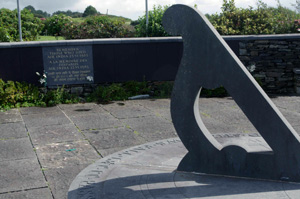 The memorial includes a well kept with a sundial that commemorates the day and hour of jumbo jet’s explosion in the air. There is a low, stone, semi-circle wall with the names of the victims that appears to cup the sundial. (Picture 4)A tidy garden maintained by the village borders the path to the memorial, which is oriented towards the breezy, wide-open ocean.
The memorial includes a well kept with a sundial that commemorates the day and hour of jumbo jet’s explosion in the air. There is a low, stone, semi-circle wall with the names of the victims that appears to cup the sundial. (Picture 4)A tidy garden maintained by the village borders the path to the memorial, which is oriented towards the breezy, wide-open ocean. At one point, we had to stop for a flock of sheep across the road which gave the weathered sheepherder time to walk up to the van. He quickly fired off about a dozen personal questions in a sing-songy Irish accent including asking where were we from, where were we going and was I married. Driver Walsh had predicted we were going to be there a long time when the sheepherder headed towards us. Walsh was greatly relieved when another car came around the bend and the sheepherder had new people to question.
At one point, we had to stop for a flock of sheep across the road which gave the weathered sheepherder time to walk up to the van. He quickly fired off about a dozen personal questions in a sing-songy Irish accent including asking where were we from, where were we going and was I married. Driver Walsh had predicted we were going to be there a long time when the sheepherder headed towards us. Walsh was greatly relieved when another car came around the bend and the sheepherder had new people to question.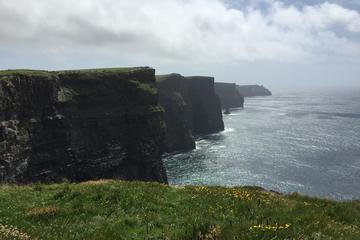
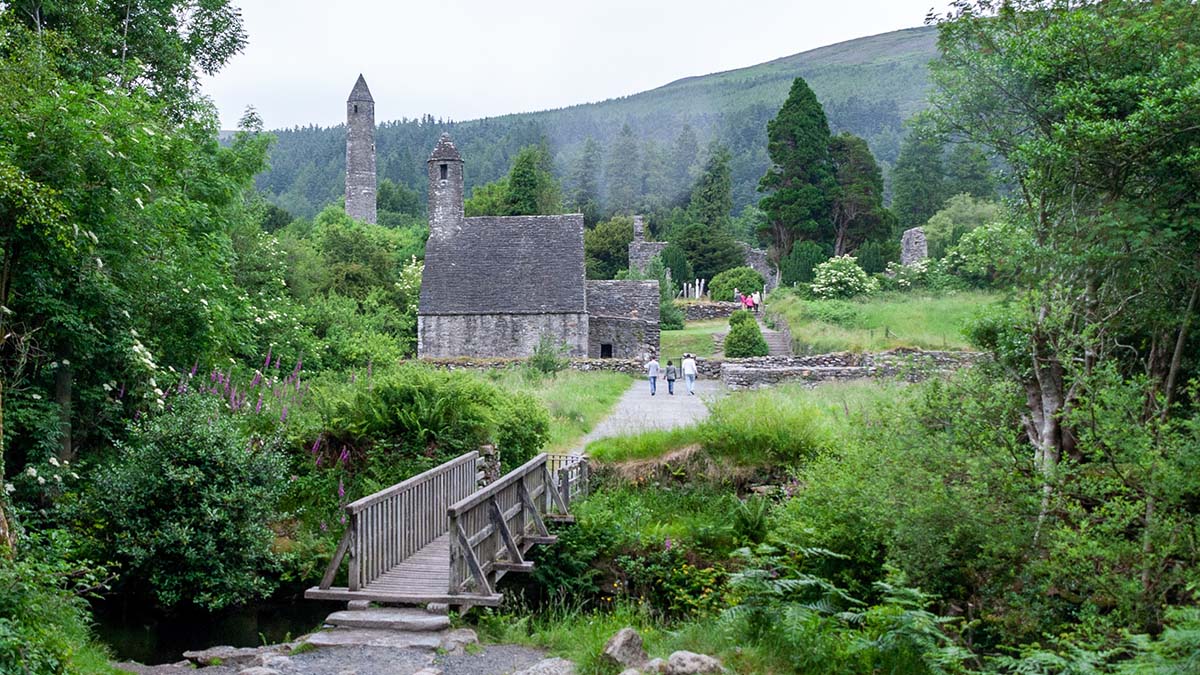
 It is a sunny spring morning, perfect for a trip to Glendalough, an ancient “monastic city” set in a surround of Wicklow Mountains National Park, about an hour south of Dublin. Our local guide keeps us alert on the bus ride, pointing out the flora and fauna–the beauty of the yellow gorse which in other non-flowering seasons gets pelted with words such as weed, invasive, and noxious, the blossoming white thorn hedges, shades of green in the long vistas. As we zoom past farms and real estate signs, she chats about the state of the nation in this time of recession. “People cannot sell their properties; their mortgages are worth more than their houses. There is no longer a construction industry.”
It is a sunny spring morning, perfect for a trip to Glendalough, an ancient “monastic city” set in a surround of Wicklow Mountains National Park, about an hour south of Dublin. Our local guide keeps us alert on the bus ride, pointing out the flora and fauna–the beauty of the yellow gorse which in other non-flowering seasons gets pelted with words such as weed, invasive, and noxious, the blossoming white thorn hedges, shades of green in the long vistas. As we zoom past farms and real estate signs, she chats about the state of the nation in this time of recession. “People cannot sell their properties; their mortgages are worth more than their houses. There is no longer a construction industry.” But the Roman church had crossed the choppy waters of the Irish Sea. Representatives had been dispatched from Rome in the 400s and the escaped slave Patrick had returned as a missionary in that same century. Glendalough was established in the early 500s by Coemgen (Caoimhin), St. Kevin. His Gaelic name means “fair-begotten.” Does it refer to his royal Irish birth or to his good looks? As a child, Kevin was tutored by Petroc of Cornwall, a Welsh-born Irish-educated saint. Kevin lived and studied with the monks and was eventually ordained himself.
But the Roman church had crossed the choppy waters of the Irish Sea. Representatives had been dispatched from Rome in the 400s and the escaped slave Patrick had returned as a missionary in that same century. Glendalough was established in the early 500s by Coemgen (Caoimhin), St. Kevin. His Gaelic name means “fair-begotten.” Does it refer to his royal Irish birth or to his good looks? As a child, Kevin was tutored by Petroc of Cornwall, a Welsh-born Irish-educated saint. Kevin lived and studied with the monks and was eventually ordained himself. What compels me to forgo another day in Dublin for this side trip into the country? Being neither Irish nor Catholic nor even very religious, what can explain my interest in, my attraction to, this site? I have been to one of these ancient monasteries before–to Clonmacnoise on the River Shannon. Is it nostalgia, for that much earlier life-changing visit? It was from the friend who guided me to Clonmacnoise that I learned how to pronounce Glendalough. Glen da lock (loch). Not loo; it does not rhyme with slough, as I had incorrectly assumed that first time. Glenn da locha, the valley of the two lakes. The two communities were connected in the sixth century, by the friendship of Ceiran and Kevin. Both locations feature thirty-metre-tall round towers, thought to have been used like beacons, for navigating, as bell towers to signal distress, as safe storage for valuables such as psalters and illuminated manuscripts, and as places of refuge during times of attack. The monasteries include hermit cells, probably the only constructs that either saint actually touched. St. Kevin’s is a cave above the lake. The chapel, St. Kevin’s Kitchen, the rest of the existing ruins, date from between the ninth and twelfth centuries.
What compels me to forgo another day in Dublin for this side trip into the country? Being neither Irish nor Catholic nor even very religious, what can explain my interest in, my attraction to, this site? I have been to one of these ancient monasteries before–to Clonmacnoise on the River Shannon. Is it nostalgia, for that much earlier life-changing visit? It was from the friend who guided me to Clonmacnoise that I learned how to pronounce Glendalough. Glen da lock (loch). Not loo; it does not rhyme with slough, as I had incorrectly assumed that first time. Glenn da locha, the valley of the two lakes. The two communities were connected in the sixth century, by the friendship of Ceiran and Kevin. Both locations feature thirty-metre-tall round towers, thought to have been used like beacons, for navigating, as bell towers to signal distress, as safe storage for valuables such as psalters and illuminated manuscripts, and as places of refuge during times of attack. The monasteries include hermit cells, probably the only constructs that either saint actually touched. St. Kevin’s is a cave above the lake. The chapel, St. Kevin’s Kitchen, the rest of the existing ruins, date from between the ninth and twelfth centuries.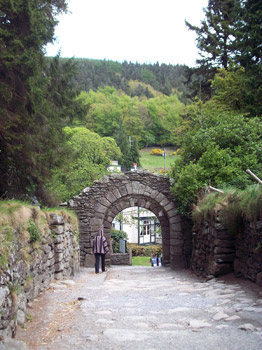 Both monasteries contain a collection of ruined buildings with designations such as cathedral, church, chapel, along with a profusion of Celtic crosses and gravestones. Here those who found a community while living are surrounded still in a community of the dead. Both sites have high crosses–the Cross of the Scriptures at Clonmacnoise and St. Kevin’s Cross at Glendalough, and evidently, a second high cross, the Market Cross, in the visitor centre.
Both monasteries contain a collection of ruined buildings with designations such as cathedral, church, chapel, along with a profusion of Celtic crosses and gravestones. Here those who found a community while living are surrounded still in a community of the dead. Both sites have high crosses–the Cross of the Scriptures at Clonmacnoise and St. Kevin’s Cross at Glendalough, and evidently, a second high cross, the Market Cross, in the visitor centre.
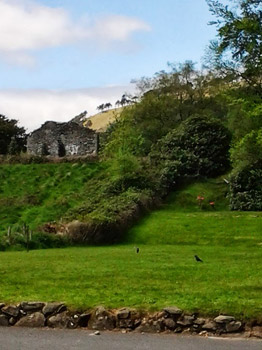 Just outside the double-arched gateway is a midway of tents and caravans. Linen tea towels, woolen “jumpers,” potato scones, postcards. Today the market of souvenir and food vendors does not even make me think of the temple and the moneylenders. After all, everyone has to eat, and it is a recession, and loaves and fishes no longer magically appear.
Just outside the double-arched gateway is a midway of tents and caravans. Linen tea towels, woolen “jumpers,” potato scones, postcards. Today the market of souvenir and food vendors does not even make me think of the temple and the moneylenders. After all, everyone has to eat, and it is a recession, and loaves and fishes no longer magically appear.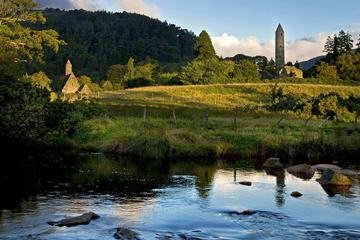


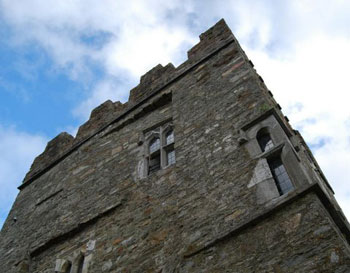 When the castle was built, Kinsale was a busy port, doing much trade with the Continent, and King Henry VII had granted Maurice Fitzgerald, Earl of Desmond the right to impose a levy on incoming cargoes … especially wine! For this reason, Desmond Castle had the alternative name of the Custom House. The Desmonds rebelled against the Crown in the late 16th Century, so lost this right, along with their lands. Shortly afterwards, the castle figured in what was to become known as the Nine Years War.
When the castle was built, Kinsale was a busy port, doing much trade with the Continent, and King Henry VII had granted Maurice Fitzgerald, Earl of Desmond the right to impose a levy on incoming cargoes … especially wine! For this reason, Desmond Castle had the alternative name of the Custom House. The Desmonds rebelled against the Crown in the late 16th Century, so lost this right, along with their lands. Shortly afterwards, the castle figured in what was to become known as the Nine Years War.
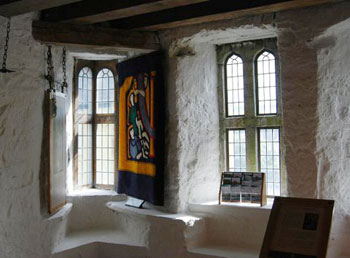 In the 17th and 18th Centuries, the castle was used as a prison for Spanish and French PoWs during a succession of Continental wars. It even housed a few American prisoners from the War of Independence. In between wars, it was used to house ‘home grown’ felons, until the 1840s, when it became a Famine Relief Centre and a workhouse, then used for various military purposes until it fell into disuse.
In the 17th and 18th Centuries, the castle was used as a prison for Spanish and French PoWs during a succession of Continental wars. It even housed a few American prisoners from the War of Independence. In between wars, it was used to house ‘home grown’ felons, until the 1840s, when it became a Famine Relief Centre and a workhouse, then used for various military purposes until it fell into disuse.